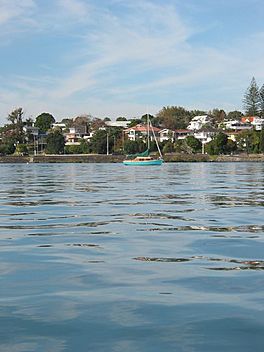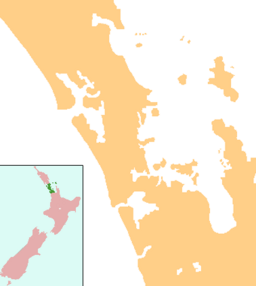Coxs Bay facts for kids
Quick facts for kids Opoututeka / Coxs Bay |
|
|---|---|

Opoututeka (Coxs Bay), Auckland, NZ
|
|
| Location | Waitematā Harbour |
| Coordinates | 36°51′00″S 174°43′30″E / 36.849917°S 174.725041°E |
| River sources | Coxs Creek |
| Basin countries | New Zealand |
| Max. length | 1 km (0.62 mi) |
| Max. width | 1 km (0.62 mi) |
| Surface area | 1 km2 (0.39 sq mi) |
| Average depth | .2 metres (0.66 ft) |
Coxs Bay, also known as Opoututeka, is a lovely bay in Auckland, New Zealand. It is part of the big Waitematā Harbour. The bay is surrounded by several suburbs. These include Westmere and Herne Bay. Ponsonby and Grey Lynn are also nearby.
This bay is special because of a long natural feature. It is protected from the west by Meola Reef. This reef is actually a very long lava flow. It came from one of Auckland's ancient volcanoes.
Discovering Coxs Bay
Coxs Bay is a fascinating place with a long history. It has played an important role in the growth of Auckland. From early settlements to busy industries, the bay has seen many changes. Today, it is a calm spot for the community.
A Look at History
The land around Coxs Bay was one of the first areas bought by Europeans in Auckland. This happened in 1840. The western edge of this land was a stream called Cox's Creek. It was also known as "the river called Opou."
Soon after, in the early 1840s, a family named John and Jane Cox started farming here. They grew vegetables for sale. Because of them, the area became known as Richmond.
In 1859, the "village of Richmond" was planned out. New streets were created. These streets are now called Regina, Kingsley, Livingstone, Webber, and Edgars. Logs for building early houses were floated up Cox's Creek. They were then cut into planks right on the spot.
Busy Times in the Bay
Industry started to grow in the area around 1860. A brick factory opened. The bricks were sent by boat from Cox's Creek to Auckland. This shows how important the creek was for transport.
Later, in 1899, a large sawmill was built. It was run by steam power. This mill was right next to the creek. The bay and creek were used to move logs and cut timber. Many local people did not like the mill. They protested strongly. But it kept working until 1920.
The sawmill then accidentally caught fire. It burned down completely. The sawdust and timber kept smouldering for over a year. This event changed the bay's future.
Connecting the Community
After the sawmill fire, a causeway was built across the bay. A causeway is like a raised road over water. This new causeway connected the growing suburb of Westmere to Herne Bay and the city. It made travel much easier for people.
Just after the causeway was finished, a Sea Scout group set up their base. They built their headquarters, called Hawke Sea Scout Hall, in 1928. This building is still a very important part of the local community today. It is a well-known landmark in the area.


